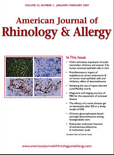
American Journal of Rhinology & Allergy
Scope & Guideline
Exploring innovative therapies for respiratory health.
Introduction
Aims and Scopes
- Chronic Rhinosinusitis Research:
This includes studies on the pathophysiology, treatment outcomes, and management strategies for chronic rhinosinusitis, with a particular emphasis on nasal polyps and eosinophilic chronic rhinosinusitis. - Allergic Rhinitis and Immune Response:
Research in this area focuses on the mechanisms of allergic responses, the efficacy of immunotherapy, and the impact of various treatment modalities on allergic rhinitis. - Surgical Techniques and Innovations:
The journal publishes articles on new surgical techniques, outcomes of various rhinologic procedures, and advancements in endoscopic surgery for sinonasal conditions. - Olfactory Dysfunction Studies:
Investigations into the causes, prevalence, and treatment of olfactory dysfunction, particularly in the context of chronic rhinosinusitis and post-viral syndromes. - Biologics and Pharmacotherapy:
Research on the use of biologic therapies for treating chronic rhinosinusitis and allergic conditions, including their efficacy, safety, and mechanisms of action. - Patient-Centered Outcomes:
The journal emphasizes studies assessing quality of life, patient-reported outcomes, and the psychosocial implications of rhinologic diseases.
Trending and Emerging
- Biologics and Targeted Therapies:
There is a growing body of literature on the efficacy and safety of biologic agents like Dupilumab and Mepolizumab in managing chronic rhinosinusitis and allergic conditions, reflecting a shift towards personalized medicine. - AI and Machine Learning Applications:
Emerging studies are exploring the role of artificial intelligence and machine learning in diagnosis, treatment planning, and patient education within rhinology, indicating a technological advancement in the field. - Longitudinal Outcomes Studies:
Research focusing on long-term outcomes of surgical and medical interventions for chronic rhinosinusitis and allergic rhinitis is gaining traction, emphasizing the importance of sustained patient-centered care. - Impact of Environmental Factors on Rhinologic Conditions:
An increasing number of studies are examining how environmental factors, such as air pollution and climate change, affect the prevalence and severity of allergic and sinonasal diseases. - Psychosocial and Quality of Life Research:
There is a notable increase in studies assessing the psychosocial impact and quality of life outcomes for patients with rhinologic conditions, highlighting the importance of holistic patient care.
Declining or Waning
- Traditional Antibiotic Use in Sinusitis:
Research on traditional antibiotic treatment patterns for sinusitis has decreased, possibly due to increasing awareness of antibiotic resistance and a shift toward more evidence-based approaches. - Non-Surgical Management of Chronic Rhinosinusitis:
There has been a noticeable reduction in studies focusing on non-surgical management strategies for chronic rhinosinusitis, as the field increasingly emphasizes surgical interventions and biologic therapies. - Basic Science Studies on Sinonasal Anatomy:
Research centered solely on anatomical studies of the sinonasal complex has diminished, likely due to the growing focus on translational research that connects clinical outcomes with anatomical insights. - General Public Health Studies:
The journal has seen fewer publications on broader public health implications of rhinologic conditions, as the focus has shifted toward more specific clinical and therapeutic studies. - Epidemiological Studies of Allergic Conditions:
There is a decline in epidemiological research specifically targeting allergic conditions, possibly due to a saturation of existing data and a shift toward more mechanistic studies.
Similar Journals
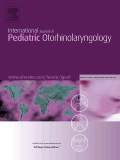
INTERNATIONAL JOURNAL OF PEDIATRIC OTORHINOLARYNGOLOGY
Innovating research for healthier futures in pediatric otorhinolaryngology.INTERNATIONAL JOURNAL OF PEDIATRIC OTORHINOLARYNGOLOGY, published by Elsevier Ireland Ltd, stands as a pivotal resource in the fields of pediatric otorhinolaryngology, pediatrics, and related medical disciplines. With a historical publication record spanning from 1979 to 2024, this journal is dedicated to advancing research and clinical practice in the diagnosis and treatment of ear, nose, and throat disorders in children. As evidenced by its 2023 rankings, the journal maintains a commendable position within the Q2 category of its field, reflecting its impact and the quality of research it disseminates, ranking #43 out of 123 in Otorhinolaryngology and #131 out of 330 in Pediatrics. Researchers, clinicians, and students alike can benefit from a wealth of studies and reviews designed to inform and enhance pediatric care. Although the journal does not currently offer open access, it remains an indispensable tool for those seeking to stay at the forefront of pediatric health and otolaryngological innovations.

Asia Pacific Allergy
Pioneering Studies in Dermatology and ImmunologyAsia Pacific Allergy, published by Lippincott Williams & Wilkins, is a prominent academic journal dedicated to advancing research and clinical practice in the fields of dermatology, immunology, and allergy. With its ISSN 2233-8276 and E-ISSN 2233-8268, the journal provides a platform for innovative studies and reviews that cater to an international audience of researchers, healthcare professionals, and students involved in allergy and related disorders. Although it does not currently offer open access to its publications, the journal's robust output from 2015 to 2017 and its ongoing contribution to the literature from 2021 to 2024 showcase the evolving landscape of allergy research in the Asia Pacific region. Recognized in the 2023 Journal Citation Reports, it holds a Q2 ranking in Dermatology and a Q3 ranking in Immunology and Allergy, while its Scopus ranks further emphasize its significance within these domains, positioning it among the top journals in the field. As a source of cutting-edge research, Asia Pacific Allergy plays a vital role in fostering collaboration and knowledge dissemination, ultimately assisting in the betterment of patient care and treatment strategies across the region.

Current Allergy & Clinical Immunology
Navigating the complexities of allergy and immunity.Current Allergy & Clinical Immunology is a vital peer-reviewed journal published by the Allergy Society of South Africa, focused on advancing the field of immunology and allergy medicine. With an ISSN of 1609-3607, this journal offers crucial insights and research findings pertinent to the understanding and treatment of allergic conditions. Operating from South Africa, it features contributions from a diverse range of authors and professionals in the field. Published from 2008 to 2024, the journal plays an essential role in disseminating current knowledge, even as it holds a Q4 ranking in Immunology and Allergy and is positioned at the 4th percentile based on Scopus rankings. While not open access, it remains an important resource for researchers, practitioners, and students looking to stay informed on emerging trends and breakthroughs in allergy and clinical immunology.

RHINOLOGY
Pioneering insights into otorhinolaryngology.RHINOLOGY is a premier journal dedicated to the field of otorhinolaryngology, published by the International Rhinologic Society. With a notable impact factor reflecting its standing in the academic community, RHINOLOGY ranks in the Q1 quartile for both Medicine (miscellaneous) and Otorhinolaryngology, placing it among the top-tier journals in the field. Since its inception in 1973, this biannual publication has served as a vital resource for researchers, clinicians, and students, covering a broad range of topics related to nasal and sinus disorders, their pathophysiology, diagnosis, and treatment. The journal's commitment to disseminating high-quality research ensures that it remains at the forefront of advancements in rhinology, making it an essential platform for those seeking to contribute to and stay informed about critical developments in this ever-evolving discipline. The journal operates under a traditional subscription model, providing access to its valuable content primarily through academic libraries and institutions.
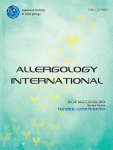
ALLERGOLOGY INTERNATIONAL
Connecting scholars to combat allergic diseases.ALLERGOLOGY INTERNATIONAL is a prestigious, peer-reviewed journal dedicated to advancing the field of immunology and allergy research. Published by the Japanese Society of Allergology, this Open Access journal has been democratizing knowledge since 1996, providing a platform for the latest findings and clinical practices in the management of allergic diseases. Its impressive Q1 ranking in both Immunology and Allergy** and **Medicine (miscellaneous)** categories in 2023 highlights its significance in the global scientific community, with a commendable Scopus ranking of #31 out of 233 in the field of immunology. The journal's focus on innovative research, comprehensive reviews, and case studies ensures that it remains a vital resource for researchers, healthcare professionals, and students alike. Situated in Tokyo, Japan, it continues to bridge gaps in allergy-related health information and foster international collaboration among scholars.

Frontiers in Allergy
Pioneering advancements in allergy and immune health.Frontiers in Allergy is a pioneering open-access journal published by FRONTIERS MEDIA SA, dedicated to advancing the frontiers of research in the fields of Immunology and Infectious Diseases. Launched in 2020 and based in Lausanne, Switzerland, this journal provides a dynamic platform for researchers, professionals, and students to share innovative findings and insights related to allergic disorders and their broader immunological implications. With a respectable Q2 ranking in both Immunology and Allergy and Infectious Diseases categories, as well as being indexed in Scopus, this journal is emerging as a significant resource for the scientific community. The open-access model ensures wide dissemination of valuable knowledge, facilitating collaboration and breakthroughs in treatments and understanding of allergies and related conditions. Frontiers in Allergy invites contributions that drive forward the understanding of immune responses, allergy prevention, and management, solidifying its role as a crucial player in the sustainability and growth of health sciences.

Postepy Dermatologii i Alergologii
Innovating research in Dermatology and Immunology.Postepy Dermatologii i Alergologii is a distinguished Open Access journal published by TERMEDIA PUBLISHING HOUSE LTD, dedicated to advancing the fields of Dermatology and Immunology and Allergy. Since its inception in 2003, this journal has served as a vital platform for researchers and practitioners alike, promoting knowledge sharing and collaboration in Poland and beyond. With a current impact ranking placing it in the Q3 quartile for both Dermatology and Immunology and Allergy categories, it plays a significant role in contributing to academic discourse within these fields. The journal is indexed in Scopus, with respectable rankings reflecting its relevance and quality—#65/142 in Dermatology and #163/233 in Immunology and Allergy. Researchers are encouraged to explore a vast array of innovative studies and reviews, making it an essential resource for anyone seeking to stay at the forefront of dermatological and allergic research. For those interested in discovering groundbreaking findings and contributing to the ongoing dialogue in these disciplines, Postepy Dermatologii i Alergologii offers not only free accessibility but also a commitment to scholarly excellence.
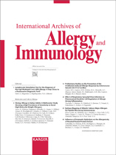
INTERNATIONAL ARCHIVES OF ALLERGY AND IMMUNOLOGY
Connecting Researchers and Clinicians in Allergy Science.INTERNATIONAL ARCHIVES OF ALLERGY AND IMMUNOLOGY, published by KARGER, is a distinguished journal dedicated to advancing the field of immunology and allergy research. With an ISSN of 1018-2438 and an E-ISSN of 1423-0097, this journal has been a vital resource since its inception in 1950, continuing to publish influential articles through 2024. Hailing from Switzerland, it holds an important position within the Q3 category in Immunology and Allergy and Q2 in miscellaneous Medicine, reflecting its growing impact in the scientific community. The Scopus rankings showcase its relevance, with a 52nd percentile in Immunology and Allergy and 45th in Immunology and Microbiology. Although not an open-access journal, it plays a critical role in disseminating significant findings and innovations in the understanding of allergic diseases and immunological responses. The INTERNATIONAL ARCHIVES OF ALLERGY AND IMMUNOLOGY is essential for researchers, clinicians, and students eager to stay at the forefront of allergy and immunology developments.
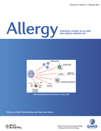
ALLERGY
Leading the Charge in Allergy Research and Education.ALLERGY is a leading international journal published by WILEY, dedicated to advancing the understanding of allergic diseases and immunology. With an ISSN of 0105-4538 and an E-ISSN of 1398-9995, this esteemed journal has been at the forefront of the field since its inception in 1948 and continues to publish high-quality research up until 2024. Positioned in the Q1 category for both Immunology and Allergy, ALLERGY ranks impressively within the top percentiles of its categories, underscoring its significant impact, as reflected in its Scopus rankings (#11 out of 233 in Immunology and Allergy, and #14 out of 236 in Immunology and Microbiology). Researchers and practitioners accessing this journal can expect a rigorous selection of peer-reviewed articles that address current challenges, innovative therapies, and advancements in the immunological sciences. Although it is not an open-access journal, ALLERGY remains vital for academics, healthcare professionals, and students alike, fostering a deeper understanding of the mechanisms and treatments associated with allergies.
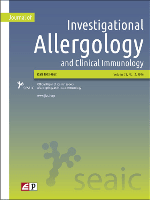
JOURNAL OF INVESTIGATIONAL ALLERGOLOGY AND CLINICAL IMMUNOLOGY
Connecting researchers and practitioners in Allergy and Immunology.JOURNAL OF INVESTIGATIONAL ALLERGOLOGY AND CLINICAL IMMUNOLOGY is an esteemed publication dedicated to the fields of Immunology and Allergy, published by ESMON PUBLICIDAD S A in collaboration with the Department of Allergy and Clinical Immunology at the University Clinical Navarra, Spain. With its rich history spanning over three decades since its inception in 1991, this journal has gained prominence in the scientific community, holding a commendable Q2 quartile in Allergy and a Q3 quartile in Immunology. Ranked within the top tiers of its categories according to Scopus, it stands at Rank #80/233 in Immunology and Allergy, and Rank #96/236 in Immunology and Microbiology, indicating its influential role in disseminating cutting-edge research and clinical insights. Though primarily print-focused, the journal strives to bridge gaps in knowledge and contribute to the ongoing dialogue among researchers, professionals, and students in the immunological sciences. The JOURNAL OF INVESTIGATIONAL ALLERGOLOGY AND CLINICAL IMMUNOLOGY is essential for anyone committed to advancing the understanding of allergic and immunological conditions.